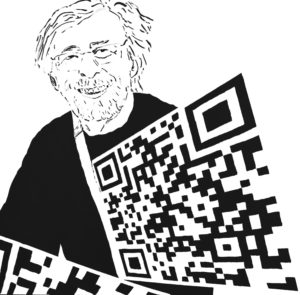Référence :
21414-1
Titre :
Malevitch Quick Response
Date :
2014
Technique :
Acrylique sur toile
Famille/Série
Dimensions
92,5 x 92,5
Signature
|
Provenance
Collection particulière Françoise Galland
Observations
Tweet en 2012 transformé en 2 Toiles en 2014
Expositions
Musée Vasarely Budapest
Bibliographie
Malevitch actualisé
Le célèbre Carré noir sur fond blanc du peintre suprématiste Malevitch (1915) actualisé en Quick Response.
Réf : Blog Tweetart 10/06/2012
Malevitch QR
Du Carré noir sur fond blanc de Malevitch en 1915 aux carrés noirs sur fond blanc des codes-barres Quick Response d’aujourd’hui: l’image change moins que le sens que nous lui donnons. Dire que tout a été fait en peinture, comme on le répète à satiété aujourd’hui, c’est prendre les choses à l’envers. Car ce n’est ni le pigment, ni la composition, ni même la forme qui fait la peinture. Comme Marcel Duchamp l’a montré en intitulant Pharmacie un paysage (1914), avec l’urinoir nommé Fontaine (1917), ou en ajoutant des moustaches et une barbichette à la Joconde (LHOOQ, 1919), c’est le sens social que nous lui attribuons. Le carré noir sur fond blanc a été l’absolu emblématique du suprématisme russe, puis l’annonce de la mort de la peinture par Malevitch, aujourd’hui une icône numérique d’identification rapide. Et qui scannera cette peinture avec son téléphone intelligent y lira «Art, vie, philosophie»: le sens que j’ai le pouvoir de lui donner.
Autre déclinaison actuelle: lorsque je porte aujourd’hui sur ma chemise un carré noir sur fond blanc, cela ne renvoie plus au suprématisme. C’est un signal de protestation codé socialement pour s’afficher contre le gouvernement ultra-conservateur canadien du premier ministre Harper.
Réf : Blog Avenir de l’Art 10/06/2012
URL
Malevitch Quick Response, the painting is the social meaning
From the Black Square on white ground of Malevich in 1915 to the black squares of today’s QR barcodes the image changes less than the meaning we give to it. This is a complete mistake to say again and again nowadays that everything has been done in painting, as a painting is not made of its pigment, composition or forms. Marcel Duchamp did show it by calling Pharmacy a landscape (1914), claiming Fountain an urinal (1917), or growing a moustache and a goatee to the Mona Lisa: a painting is made of the social meaning we impute to it. A black square on white ground has expressed the emblematic absolute of Russian Suprematism, a few years later it announced the death of painting by Malevich. Today it has become a digital icon of quick identification. And if you scan my painting with a smartphone you will read the words “Art, Life, Philosophy”: the meaning l have to power to give to it.
Réf : Blog Avenir de l’Art 05/12/2014
URL
Una obra de pintura cambia con su significación social
Desde el Cuadro negro sobre fondo blanco de Malévich en 1915 hacia los códigos de barras Quick Response de hoy vemos que la imagen cambia menos que el sentido que lo damos a ella. Por lo tanto es un error fundamental que repetir hasta la saciedad hoy que se ha hecho todo con la pintura hasta su obsolescencia. Marcel Duchamp lo ha demostrado titulando Farmacia un paisaje (1914), Fuente un urinario (1917), o añadiendo bigotes y una perilla en el retrato de la Gioconda (LHOOQ, 1919): no es el pigmento, tan poco la composición o las formas que hacen la pintura, sino el sentido social que se atribuye a ella. El cuadro negro sobre fondo blanco ha expresado el absolutismo extremo del suprematismo ruso antes que Malévich lo dio el sentido de anunciar el fin de la pintura, y hoy lo vemos como icono digital QR de identificación rápida. El que escañera mi pintura con su teléfono inteligente podrá leer: “Arte, vida, filosofía”: el sentido que tengo poder de darlo.
Réf : Blog Avenir de l’Art 07/12/2014
URL
Malevitch Quick Response : Der Sinn eines Gemäldes
Vom Schwzarzen Quadrat auf weißem Grund (Malevitch, 1915) bis zu den heutigen schwarzen Quadraten auf weißem Grund des Quick Response Barcode sieht man, dass das Bild sich weniger geändert hat, als der soziale Sinn den wir ihm geben. Wenn man so häufig heutzutage wiederholt, dass alles Mögliche im Bereich der Malerei schon gemacht wurde, fällt man in ein grundsätzliches Irrtum. Wie Marcel Duchamp es deutlich gezeigt hat, wenn er eine Landschaft Apotheke (1914) oder ein übliches Urinal Becken Brunnen (1917) genannt hat, oder wenn er der Mona Lisa (LHOOQ, 1919) Schnurrbärten und ein Spitzbart hinzugefügt hat, es sind weder das Pigment, noch die Komposition oder die Formen, die ein Gemälde schaffen, sondern der Sinn den wir ihm geben. Das weiße Quadrat auf weißem Grund wurde als absolutes Symbol des russischen Suprematismus anerkennt, während Malevitch einige Jahre später als eine Ankündigung des Todes der Malerei interpretiert hat. Heute seine Vermehrung in den QR Barcodes gilt als digitale Ikone der schnellen Identifizierung. Und derjenige der mein Gemälde mit seinem Smartphone scannt; wird die folgenden Wörter lesen: Leben, Kunst, Philosophie: es ist der Sinn, den ich fähig bin, ihm zu geben.
Réf : Blog Avenir de l’Art 06/12/2014
URL
马列维奇二维码
马列维奇二维码,布面丙烯,92 x 92 cm,2014
从1915年马列维奇的《白底上的黑方块》到今天二维码中白底上的无数黑方块:图像的变化并没有我们赋予它的意义的变化那么大。说绘画中的一切都已经有人做过了,正如人们今天喋喋不休重复的那样,是理解错了。因为构成绘画的既不是颜料,也不是构图,甚至不是形状。正如马塞尔·杜尚通过将一幅风景画命名为《药房》(1914),将小便器命名为《泉》(1917),或者给蒙娜丽莎加上两撇小胡子和一撮山羊胡(LHOOQ,1919)所展示的那样,构成绘画的是我们授予它的社会意义。白底上的黑方块曾经是俄国至上主义的绝对象征,然后是马列维奇对绘画已死的宣称,今天已经成为快速识别的一个数字图像。用智能手机扫描这幅画的人会读到“艺术、人生、哲学”的字样:这就是我有能力赋予它的意义。
Réf : Blog Avenir de l’Art 05/12/2014
|

